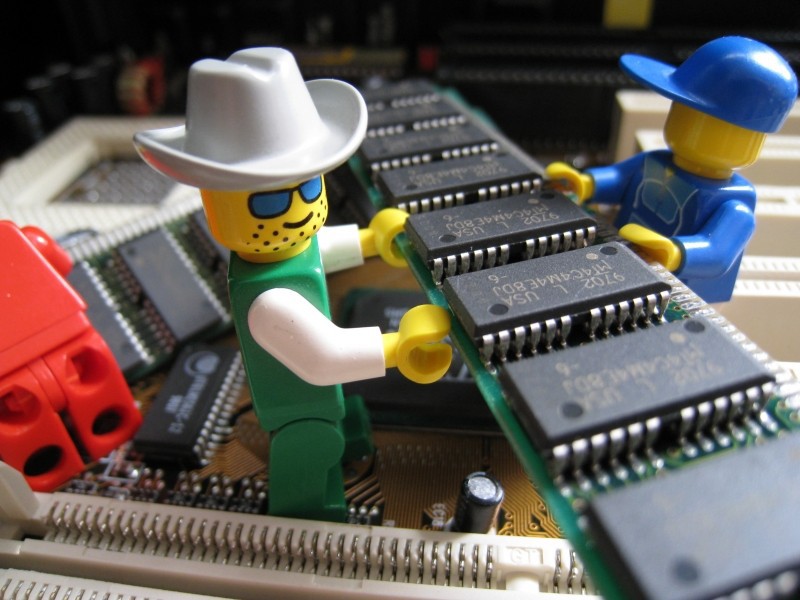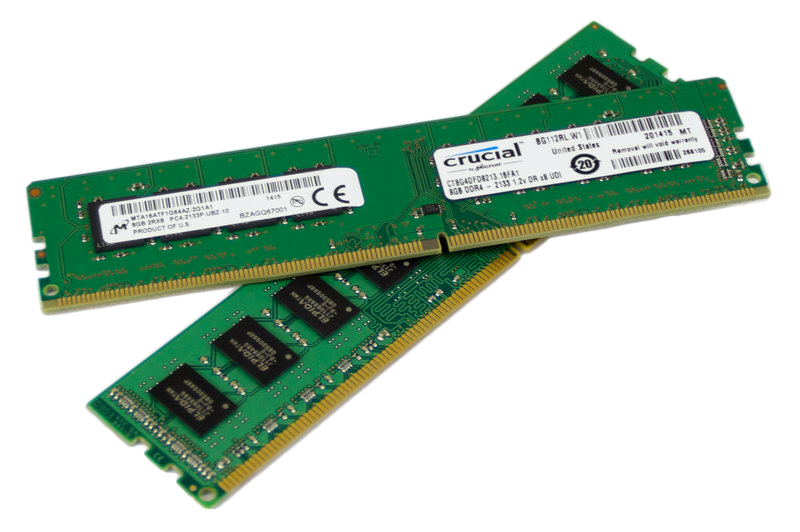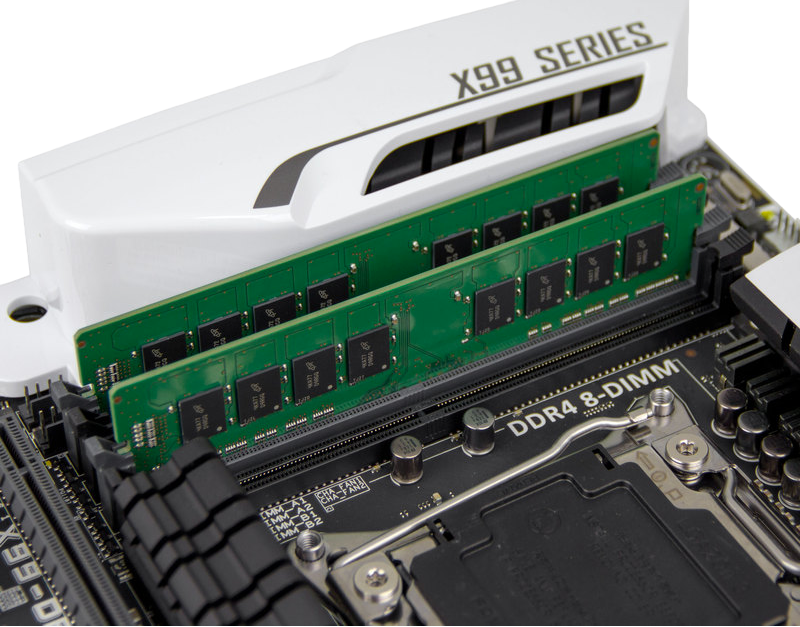What you need to know about DDR4 RAM?
This is a translation of the Tech Primer: DDR4 memory publication.

Computer technology is rapidly evolving, being replaced by new parameters and specifications, but RAM has an advantage in time. DDR SDRAM was launched in 2000 and three years passed, before the arrival of DDR2 SDRAM in 2003. DDR2 lasted four years, in 2007 it was replaced by DDR3 SDRAM. Since then, it has been unchanged for seven years, but the launch of DDR4 has been accomplished.

')
Externally, DDR4 is the same width as DDR3, but slightly higher by about 9 mm. The difference between DDR3 and DDR4 is that DDR4 uses 288 pins compared to 240 per DDR3 and the key is in a different place.
Many cosmetic changes, but four major improvements to DDR4 SDRAM:
DDR3 runs at 1.5 volts with modules running at 1.35 V. DDR4 initially runs at 1.2 volts with modules at 1.05 V. In addition, DDR4 supports a number of power saving improvements, being activated when the system is in standby mode.
Lower operating voltage allows DDR4 to consume less power (and therefore lower operating temperature) than DDR3.

DDR4 has an operating frequency of 2133MHz (this is the limit for DDR3), eventually the frequency is around 3200MHz. DDR4 chips can also be manufactured in densities up to 16 GB (or 2 GB) per bar, which is twice the density of DDR3. This means that we will see consumer-grade hardware with a capacity of 16 GB, and 64 GB on the server-level memory bar.
Like most new technologies, DDR4 is not perfect. Prices will be higher by 20-50% than the same DDR3 slats. As demand increases, the cost will decrease, but now DDR4 will simply be more expensive.
The second problem is that despite the higher DDR4 frequencies than DDR3, the timing is worse.
DDR3-2133MHz strips usually have a CL10-CL11, the current DDR4-2133Mhz strips will grieve the CL15. This is not a surprise, the situation repeats itself when DDR3 was introduced, but this does not mean that the fourth generation is inferior to its predecessor, only at first.
When comparing the Core i7 5960X and 4960X, Geekbench reports only slightly different points with DDR4-2133MHz compared to DDR3-1600MHz (5691 against 5382). Higher frequencies will be achieved in the near future, it remains to shorten the timing, and we will see the power of DDR4.
RAM is a very important aspect of modern PC. Fast memory is not bad, but the performance features are not the main advantage of DDR4 over DDR3.
DDR4 requires a completely different chipset and processor, unlike DDR3, so you cannot call DDR4 a reference. A more detailed comparison of the DDR4 / x99 / Haswell-E -VS- DDR3 Core i7 5960X in the article
Two things are most important: reduced operating voltage and high memory density. With a lower temperature regime, the components are much more reliable with respect to their fellows.

Opinion of the author
If you choose one aspect of DDR4 as the most important, then the memory density is my choice. This is a huge plus, which makes DDR4 more desirable compared to DDR3.
Programs and data types are getting bigger and more complex, more RAM will become more and more significant. Already about 33% are based on X79, sold to Puget Systems, since January 2014 the amount of memory that can be installed in the system using 8x 8 GB slats or 64 GB of RAM in total has already been exceeded. This is a huge part of Puget Systems sales, since DDR4 has great potential and I would like to see it in high-performance workstations.
Headline Photo - Daniel Dionne .
UPD 11/19/204: Sorry for the errors and the complexity of understanding the translation. Thank you for your criticism and attention.

Computer technology is rapidly evolving, being replaced by new parameters and specifications, but RAM has an advantage in time. DDR SDRAM was launched in 2000 and three years passed, before the arrival of DDR2 SDRAM in 2003. DDR2 lasted four years, in 2007 it was replaced by DDR3 SDRAM. Since then, it has been unchanged for seven years, but the launch of DDR4 has been accomplished.

')
What's new in DDR4?
Externally, DDR4 is the same width as DDR3, but slightly higher by about 9 mm. The difference between DDR3 and DDR4 is that DDR4 uses 288 pins compared to 240 per DDR3 and the key is in a different place.
Many cosmetic changes, but four major improvements to DDR4 SDRAM:
- Lower operating voltage
- Increase energy saving
- Frequency increase
- Chip Sealing.
DDR3 runs at 1.5 volts with modules running at 1.35 V. DDR4 initially runs at 1.2 volts with modules at 1.05 V. In addition, DDR4 supports a number of power saving improvements, being activated when the system is in standby mode.
Lower operating voltage allows DDR4 to consume less power (and therefore lower operating temperature) than DDR3.

DDR4 has an operating frequency of 2133MHz (this is the limit for DDR3), eventually the frequency is around 3200MHz. DDR4 chips can also be manufactured in densities up to 16 GB (or 2 GB) per bar, which is twice the density of DDR3. This means that we will see consumer-grade hardware with a capacity of 16 GB, and 64 GB on the server-level memory bar.
Cons DDR4
Like most new technologies, DDR4 is not perfect. Prices will be higher by 20-50% than the same DDR3 slats. As demand increases, the cost will decrease, but now DDR4 will simply be more expensive.
The second problem is that despite the higher DDR4 frequencies than DDR3, the timing is worse.
DDR3-2133MHz strips usually have a CL10-CL11, the current DDR4-2133Mhz strips will grieve the CL15. This is not a surprise, the situation repeats itself when DDR3 was introduced, but this does not mean that the fourth generation is inferior to its predecessor, only at first.
When comparing the Core i7 5960X and 4960X, Geekbench reports only slightly different points with DDR4-2133MHz compared to DDR3-1600MHz (5691 against 5382). Higher frequencies will be achieved in the near future, it remains to shorten the timing, and we will see the power of DDR4.
Conclusion
RAM is a very important aspect of modern PC. Fast memory is not bad, but the performance features are not the main advantage of DDR4 over DDR3.
DDR4 requires a completely different chipset and processor, unlike DDR3, so you cannot call DDR4 a reference. A more detailed comparison of the DDR4 / x99 / Haswell-E -VS- DDR3 Core i7 5960X in the article
Two things are most important: reduced operating voltage and high memory density. With a lower temperature regime, the components are much more reliable with respect to their fellows.

Opinion of the author
If you choose one aspect of DDR4 as the most important, then the memory density is my choice. This is a huge plus, which makes DDR4 more desirable compared to DDR3.Programs and data types are getting bigger and more complex, more RAM will become more and more significant. Already about 33% are based on X79, sold to Puget Systems, since January 2014 the amount of memory that can be installed in the system using 8x 8 GB slats or 64 GB of RAM in total has already been exceeded. This is a huge part of Puget Systems sales, since DDR4 has great potential and I would like to see it in high-performance workstations.
Headline Photo - Daniel Dionne .
UPD 11/19/204: Sorry for the errors and the complexity of understanding the translation. Thank you for your criticism and attention.
Source: https://habr.com/ru/post/363185/
All Articles